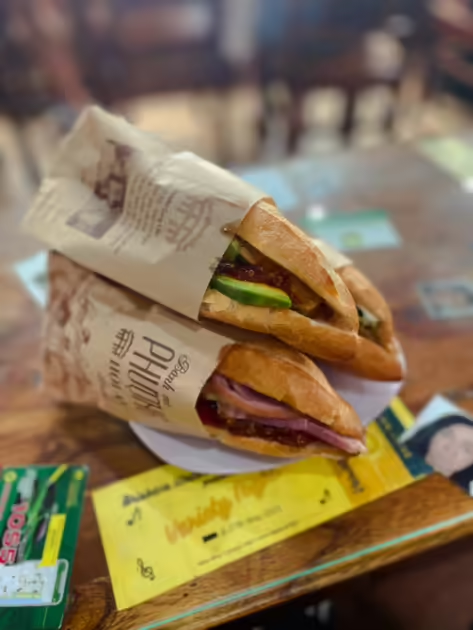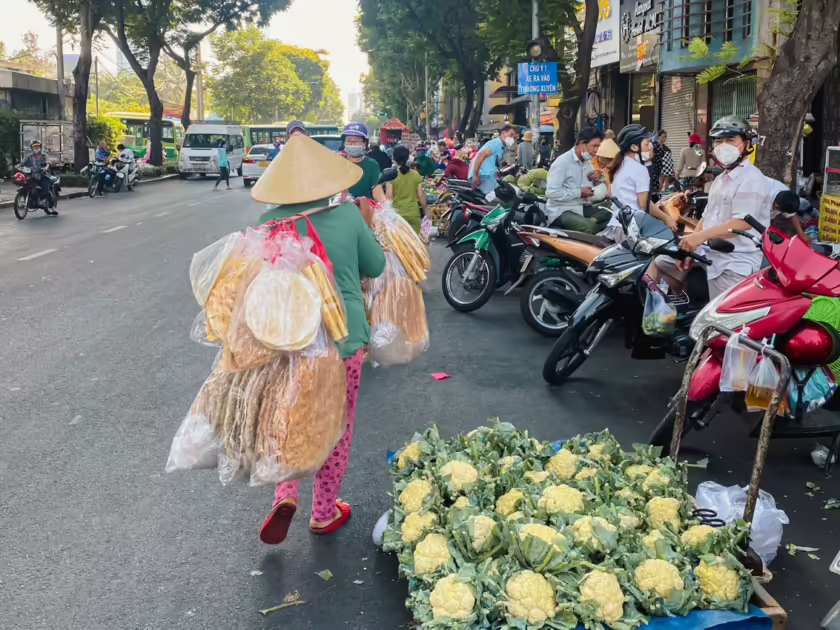18 Interesting Differences we noticed between North and South Vietnam
As a country that was only re-unified in 1975, there are of course many differences between North and South Vietnam.
When traveling across Vietnam, you’ll notice plenty of fascinating differences from one region to the next, especially between the north and the south. These changes encompass everything from landscapes and languages to climates, cultures, habits and more.
In the past some of these regional differences led to division and conflict. However today, Vietnamese are embracing all the unique characteristics of southern, central, northern, coastal, highland, urban, and rural Vietnam.
One of the most enjoyable aspects of exploring Vietnam is experiencing these distinctions. We loved observing these changes, big and small, as we traveled through this incredibly diverse country.
1. English speaking
As soon as you land in Vietnam, you’ll realize that English is not widely spoken at all in the country.
We found that the further North you are in Vietnam, the less likely you would be to hear any English. In the regions north of Hanoi for example, it can be tricky to do things like place an order in a restaurant.
In the South, most people speak English, especially the younger generations. It’s easier to communicate, and it’s easier to find English translations. Because of this, in the south, the Vietnamese culture is more accessible to outsiders.
Despite some occasional difficulties at times, wherever we were in Vietnam, we always felt welcome, and many people helped us along the way. We always managed to understand each other at some point. It’s also refreshing sometimes to take a break from relying on English for communication.
2. Weather & climate
Vietnam’s climate varies drastically from north to south. Northern Vietnam experiences distinct seasons with a cold winter with snow and hot, humid summer that is influenced by monsoons.
Southern Vietnam has a tropical climate. It has a wet season with heavy rains (from May to October) and a dry season (from November to April).
Central Vietnam has a transitional climate with more defined seasons and occasional typhoons. These climate differences are very important to consider when planning a trip to Vietnam.
3. Motorcycle & Use of Horns
Vietnam is undoubtedly the land of the motorcycle. With 50 million of them, it is the fourth highest country in the world for the number of motorcycles. Nearly 9 in 10 Vietnamese people own at least one scooter or motorcycle!
Motorcycles are ubiquitous all over the country, however, you may notice that in the north (especially Hanoi) people are constantly using their horns! This isn’t to be rude but it’s a way for them to let you know that they’re driving around you. In the South, horns and beeping are less common.
Wherever you are in the country, you will be sure to see many types of two-wheelers, often transporting a whole family, large furniture, or a large number of animals (pigs, geese, goats, or ducks)!
4. People and Fashion
We found the Northern Vietnamese people tended to be more traditional, and the Southern Vietnamese to be more outgoing.
In terms of fashion, in the South, you may find that people dress more adventurously, and in a more relaxed Western style (jeans and t-shirts). This is contrasted with the North where dress sense is more discreet, reserved, and respectful of traditions.
For example, in Hanoi you would be unlikely to see girls wearing anything like a short skirt, whereas in Ho Chi Min, this wouldn’t be anything particularly unusual.
Another difference in terms of people was seeing the different ethnic cultures, after all, Vietnam is made up of 54 different ethnic groups. Each ethnic group follows their own traditions, wears different clothes, and has their own special beliefs. We learned a great deal about these distinctions at the Vietnamese Women’s Museum in Hanoi.
5. Language and accents
The Vietnamese language called Tiếng Việt is spoken across Vietnam and shares a common base between the northern, central, and southern regions.
However there are many distinct differences from one region to another in vocabulary, tones, pronunciation, and accent. Even if you don’t speak Vietnamese, you’ll notice the distinctive accents and even some common words are different.
In general, the northern dialect is seen as the most formal and standard Vietnamese language. The southern dialects seem more relaxed with a melodic tone. Due to the region’s history, the southern dialects have influences from nearby countries such as Cambodia, and other languages like French and English.
For example, the word pineapple is said “dứa” in North Vietnam, while in Southern Vietnam, you would use “thơm.”
While these differences exist, most Vietnamese speakers can easily understand both dialects due to today’s exposure to both formal and informal language in the media and more largely internet social media.
6. Road conditions
The road network in Vietnam has massively improved over the last decade. However, the northern part of the country has many mountains and more difficult terrains sharpened by extreme weather in winter. During our Ha Giang Loop motorbike Road Trip, we noticed a lot of roadworks on many miles.
It is a constant challenge for local people to build mountain passes over high ridges and hard bends. Expect some muddy, bumpy, sandy, and difficult roads with potholes on some sections but it’s generally good enough!
The road conditions in the south are generally better as they’re easier to build on the flat land.
7. Westernization (brands, culture)
Westernization was for us the most striking difference between South and North Vietnam. As you travel from North to South you will see how the country changes.
The north has remained largely untouched by westernization and has strongly retained its own Vietnamese culture. If anything, regions North of Hanoi seem more influenced by China or Russia. Here there are very Western fast-food chains, large malls, or fashion brands (except fake designer clothing being sold in Hanoi!).
On the other side, Ho Chi Minh is the most westernized city in Vietnam. You can find McDonalds, Starbucks, and many shops like Zara or Uniqlo! People have a different way of life in the north compared to the south.
The south is also more business and finance oriented than the north and is home to more foreign companies’ headquarters. People are genuinely richer than in the north.
8. Agriculture
You can actually divide Vietnamese agriculture into three sections. In the top third of the country, with its mountainous landscapes and cooler climate, there is only one harvest per year. The central regions usually have two harvests per year. And incredibly, the the South there can be up to three harvests – in the same year!
It is no wonder that the South of Vietnam (particularly around Dalat and the Mekong Delta) is the agricultural heartland of the country.
There are also differences in the produce that is grown. In South Vietnam, the main crop is rice. The Mekong Delta, known as the “Rice Bowl of Vietnam,” is one of the world’s largest rice-producing regions. Southern farmers also produce a lot of exotic fruits like durian, mango, lychee, and dragonfruit.
In Central Vietnam, the most cultivated product by far is coffee which is mainly exported.
In North Vietnam, rice is harvested in September, other commonly grown crops are potatoes, wheat, tea, and maze. Livestock farming is also very important (buffalos, pigs, chickens).
9. Coffee & tea culture
Vietnamese love coffee. Even if they generally drink more coffee in South Vietnam, Hanoi is an exception!
You will find a coffee shop at every corner of old town with so many crazy recipes. In the northern part of Vietnam, they much prefer tea.
10. Traditional Pho soup
Pho is the most-known Vietnamese dish in the world. Indeed, you can find this national dish on every corner of any Vietnamese town, city, or village. The best Pho’s restaurants have served the same guarded family recipe for decades. But there is a major difference between the North and the South recipes:
Hanoi’s Pho: earthy flavors, light broth, and transparent thin noodles.
Saigon’s Pho: complex flavors, rich and cloudy broth with thick noodles, and many toppings.
Both Pho’s recipes are great
11. Flavors & Fish sauce
The food in Vietnam is amazing from north to south with each region having its own local specialties. The main difference we noticed was that in the south – the food tends to be sweeter and spicier. The broths are darker, and they use more oil!
In the north, flavors are more herbal and sourer with fewer ingredients used in general.
The essential Vietnamese condiment, fish sauce is served with every meal in Vietnam. In the north, the fish sauce is salty while in the south it’s sweeter!
12. Trash & Plastic Waste
Arriving in Vietnam, we were positively surprised to notice how clean the streets in Hanoi are. Everyone is sweeping dirt from the front of their shops, restaurants, and homes. This is a long-standing tradition that is very important for the northern Vietnamese.
Sadly, in the south, we noticed a lot more plastic and trash in the Mekong Delta.
13. Landscapes
Travelling through Vietnam takes you to completely different types of landscapes making it one of the most diverse countries in South East Asia.
North Vietnam is filled with high mountains and hills covered by dense jungles. Between Ninh Binh and Phong Nha, you’ll be surrounded by limestone karsts, caves, and rivers.
The southern region is flatter with a countryside vibe and many beaches.
14. Ethnic diversity
Vietnam is a diverse country with more than 50 ethnic groups throughout the country. Most of Vietnam’s population is of Kinh ethnicity (often known as “Viet”), but the rest of the significant ethnic minority communities are dispersed between North and South Vietnam. In the northern regions, you will find the Tay, Thai, Muong, and Hmong who live in the mountains and have their own dialect, customs, and traditions.
In South Vietnam, there is a more diverse range of ethnic minorities such as Khmer, Chinese, and Cham people due to the proximity with Cambodia and the Mekong Delta is an important trading hub in Southeast Asia.
15. History
Vietnam has a rich culture and history that is mostly in the North. The Ancient imperial capital Hoa is near Ninh Binh.
In the center of Vietnam, the city of Hue played a major role during the French Colonization and years after. There are so many temples, palaces, citadels, and historical sites in North Vietnam.
The power and most institutions are in Hanoi today. Whilst Ho Chi Minh is an important city in terms of culture, art, media but if you want to understand Vietnam’s history, you’ll have to travel North.
16. Rice Wine & beers
Although rice wine is drunk all over the country, it is the national drink in North Vietnam. Made from fermented rice and infused with herbs or flowers, the hearty rice wine is often home-brewed and drank like tea to keep warm during the cold winters. While traveling in north Vietnam, you will be offered a lot of rice wine in shot glasses at night – it’s a way to be hospitable and make you feel welcome!
The only other drink loved in North Vietnam is the ice-cold Bia Hoi beer. This light lager beer brewed daily, popular with locals and travelers is refreshing and very cheap!
In South Vietnam, the favorite drink by far is beer. The French introduced the beer-drinking culture during the colonization and Vietnam is one of Asia’s largest beer-drinking countries today. Southern people love a lager beer – Saigon, Hanoi, Tiger or even Heineken you call it.
The funny thing is that in the north they drink mostly Saigon beer, and, in the south, they love Hanoi and Tiger beer! Ho Chi Minh has also a lot of small breweries that serve great beers.
In central Vietnam, you can find the Dalat wine which is a fruity wine – worth trying if you are fed up with beers and rice wine!
17. Soccer on TV
We traveled from North to South Vietnam. Not a single Vietnamese ever mentioned anything about soccer or saw anyone playing in Hanoi or other northern cities. As soon as we arrived in Hue, we saw kids everywhere playing on the grass. We met lovely Vietnamese who loved to chat about football in Hoi An and it was on most screens in lively bars.
18. Dogs
Dogs are everywhere in Vietnam but don’t be surprised to see them on the menu in some restaurants in North Vietnam. This is due to the Chinese influence bordering Vietnam.







Thank you for your great information. Me and my husband are planning to go to Vietnam in September. Your information is a great input for us.
Hi Angela,
Thank you for your comment. This is great to hear!
Hope you have an amazing trip in Vietnam. 🙂